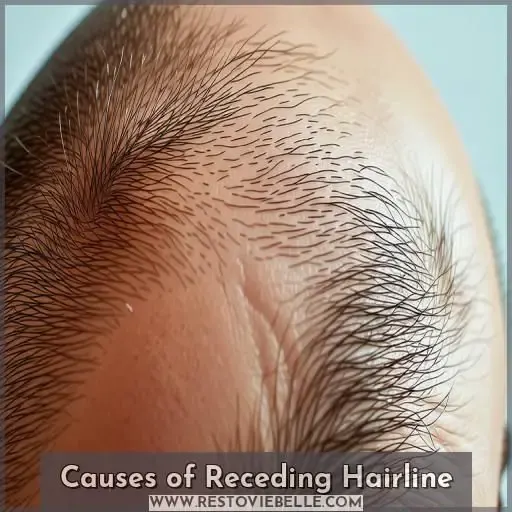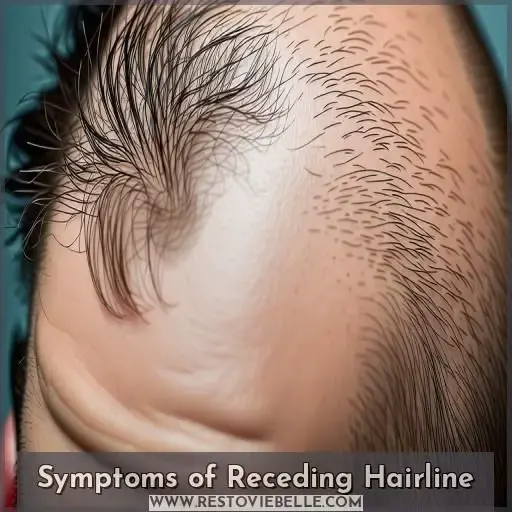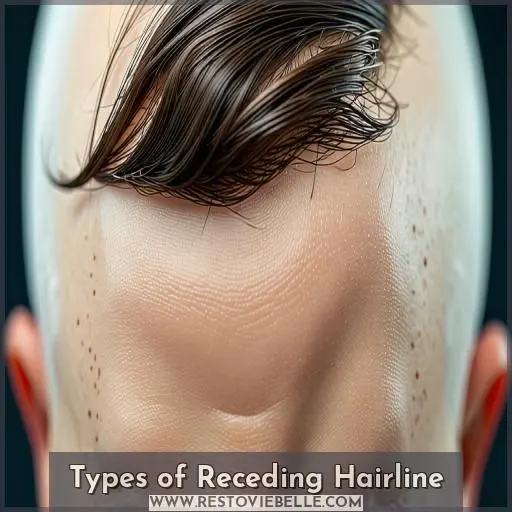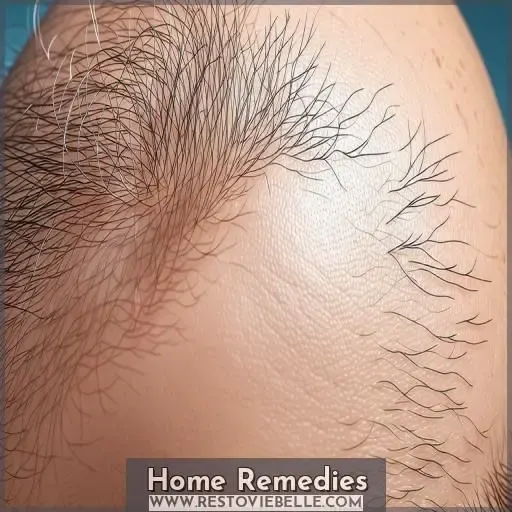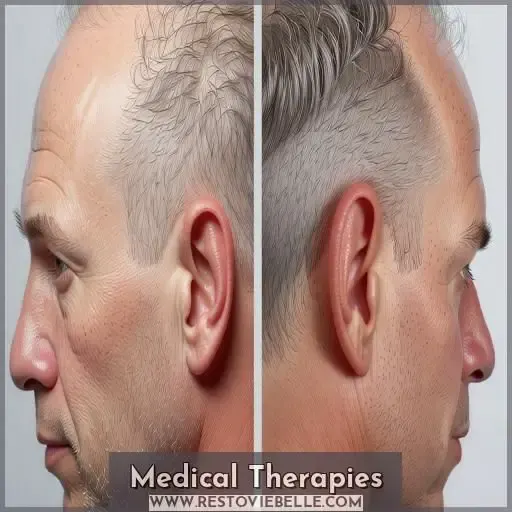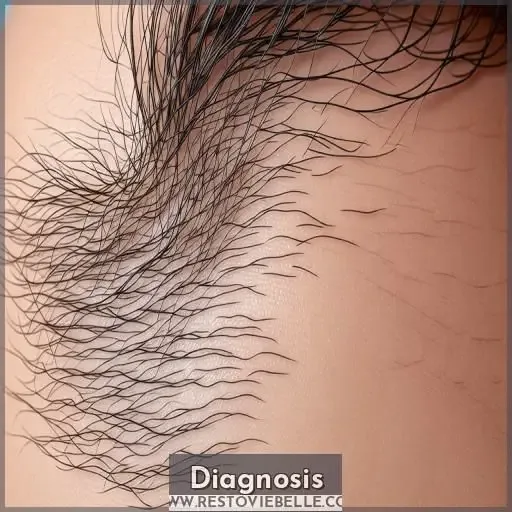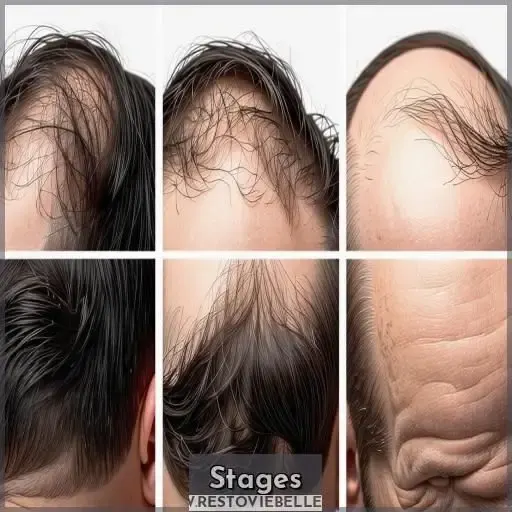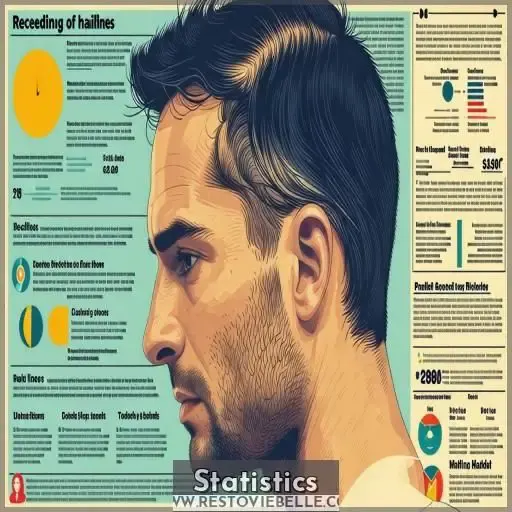This site is supported by our readers. We may earn a commission, at no cost to you, if you purchase through links.
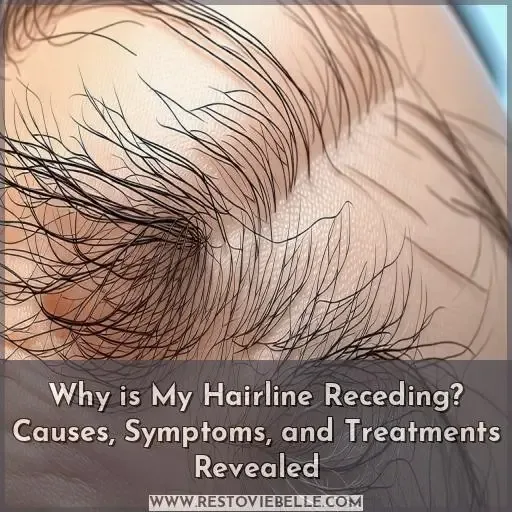 Your hairline is receding most likely due to male pattern baldness, a genetic condition influenced by hormones like DHT.
Your hairline is receding most likely due to male pattern baldness, a genetic condition influenced by hormones like DHT.
As you age, DHT causes hair follicles to shrink, leading to a receding hairline with an M-shaped pattern. Stress, poor nutrition, and harsh hairstyles can exacerbate the issue.
While it’s distressing, you’re not alone – two-thirds of men face this by age 35.
But fear not, effective treatments exist to slow or reverse the process. To regain your luscious locks, we’ll explore options from home remedies to medical therapies designed to meet your specific needs.
Once you understand the root causes, you’ll be empowered to reclaim your mane.
Table Of Contents
- Key Takeaways
- Why is My Hairline Receding?
- Causes of Receding Hairline
- Symptoms of Receding Hairline
- Types of Receding Hairline
- Home Remedies
- Medical Therapies
- Diagnosis
- Stages
- Statistics
- Frequently Asked Questions (FAQs)
- Will a receding hairline grow back?
- How do you fix a receding hairline?
- Why is my hairline receding at 18?
- Can receding hairline stop?
- How long does it take for a receding hairline to stabilize?
- Can a receding hairline be reversed naturally?
- What are the long-term effects of a receding hairline?
- How often should I get my hairline checked?
- Can stress cause a receding hairline to worsen?
- Conclusion
Key Takeaways
- Receding hairlines are most commonly caused by male pattern baldness, a genetic condition influenced by hormones like DHT that causes hair follicles to shrink over time
- Effective treatments exist to slow or reverse a receding hairline, including medications like finasteride and minoxidil, PRP therapy, low-level light therapy, and hair transplants
- Natural home remedies like herbal treatments, essential oils, and proper scalp care can also help promote hair growth and prevent further loss
- Consulting a dermatologist is important for accurately diagnosing the underlying cause of a receding hairline and developing an effective treatment plan
Why is My Hairline Receding?
Receding hairlines can be caused by genetic factors or hormonal changes, leading to gradual hair loss and thinning. Seeking medical advice can help identify the underlying cause and explore suitable treatment options.
Causes of Receding Hairline
There are three main causes behind a receding hairline:
Genetic factors, such as male pattern hair loss and frontal fibrosing alopecia.
Hormonal factors, like high levels of the hormone DHT.
Other factors like stress or illness, as well as lifestyle choices such as smoking or a poor diet, may also contribute to hair loss above the temples.
Genetic Factors
Genetics play a key role in receding hairlines. If your parents or grandparents experienced male pattern baldness, you’re more likely to develop it too . This inherited sensitivity to the male hormone dihydrotestosterone (DHT) causes hair follicles to shrink over time, leading to a receding hairline and eventual balding .
- Genetics are the primary cause of male pattern baldness, the most common type of receding hairline .
- If your family has a history of hair loss, you have a higher genetic susceptibility to developing a receding hairline .
- Certain genetic variants make some people more predisposed to hair follicle sensitivity to DHT, triggering male pattern baldness .
- Inheriting the genetic tendency for a receding hairline doesn’t mean it’s inevitable – other factors like hormones and lifestyle also play a role .
Hormonal Factors
Hormonal factors, like high levels of the male hormone DHT, can cause hair follicles to shrink and hair to thin. Medications like finasteride and minoxidil can block DHT and stimulate growth. Low-level light therapy (LLLT) and platelet-rich plasma (PRP) injections may also help. Maintaining healthy hormone levels through lifestyle changes is key to preventing further loss.
- Hormonal imbalances can trigger hair loss
- Medications like finasteride and minoxidil help
- LLLT and PRP therapy stimulate growth
- Lifestyle changes maintain healthy hormone levels
Other Factors
Stress, illness, and lifestyle choices like smoking and poor diet can also contribute to a receding hairline . Tight hairstyles that pull on the hair and chemical treatments may cause traction alopecia . Managing stress levels through exercise, relaxation techniques, and a balanced diet rich in hair-healthy nutrients like biotin and iron may help promote hair growth .
- Stress management
- Balanced diet
- Hairstyles and chemical treatments
Symptoms of Receding Hairline
You may notice thinning hair strands above your temples or a receding hairline forming a distinct ‘M’ shape – these are telltale signs of male pattern baldness. Additionally, a band of lighter skin above the forehead, along with a zigzag pattern developing along the hairline, could indicate the onset of frontal fibrosing alopecia, characterized by scarring hair follicles.
Hair Loss Signs
As your hairline starts to recede, you may notice thinning hair, decreased hair density, and a widening part line. Examine your scalp for signs of inflammation, redness, or itchiness. Changing hairstyles that pull on your hair can worsen the issue. Consult a dermatologist if you experience sudden, patchy hair loss to rule out alopecia or other underlying conditions .
Types of Receding Hairline
Male Pattern Hair Loss (MPHL) is more common in men, characterized by a receding hairline and balding on the top of the head due to high levels of DHT.
Frontal Fibrosing Alopecia (FFA) is prevalent in Black women and postmenopausal individuals, leading to an itchy scalp, hairline rash, and frontal baldness.
Recognizing these types is essential for early intervention and effective management.
Regular scalp care, a balanced diet, and low-level light therapy benefit hair growth and delay hairline recession .
Treatment Options
If your hairline is receding, don’t worry – there are effective treatments available. Medications like finasteride and minoxidil can help slow hair loss and promote regrowth . PRP therapy and low-level light therapy (LLLT) are other options . For a permanent solution, hair restoration surgery transplants healthy follicles to thinning areas . Gentle shampoos, essential oils, and home remedies may also help .
Types of Receding Hairline
There are two primary types of receding hairlines you should be aware of: male pattern hair loss and frontal fibrosing alopecia. Male pattern hair loss is more common in men and is linked to high levels of the hormone DHT, while frontal fibrosing alopecia more frequently affects black women and postmenopausal individuals, causing scarring of the hair follicles.
Male Pattern Hair Loss
Male pattern hair loss, the most common type of receding hairline, is primarily driven by genetics and hormones. High levels of the male hormone DHT cause hair follicles to shrink, leading to thinning hair and eventual baldness. White men are more susceptible, and it can start as early as the late teens or early twenties .
- Linked to high DHT levels
- More common in white males
- Can start in late teens or early twenties
- Stages include hairline recession, hair loss spread, balding on top of head, and frontal baldness
Frontal Fibrosing Alopecia
Frontal fibrosing alopecia, a type of receding hairline, disproportionately affects black women and postmenopausal individuals. This condition causes scarring of the hair follicles, leading to an itchy scalp, hairline rash, and progressive hair loss. Unlike male pattern baldness, frontal fibrosing alopecia can strike at any age or sex. Treatment focuses on slowing progression and managing symptoms.
- Scarring of hair follicles
- Itchy scalp and hairline rash
- More common in black women and postmenopausal people
- Can affect any age or sex
- Treatment aims to slow progression and manage symptoms
Home Remedies
You may find relief from a receding hairline through natural home remedies.
Herbal treatments like saw palmetto, ginseng, aloe vera, and Indian gooseberries have shown promising results in increasing hair density and quality.
Essential oils such as rosemary, cedarwood, peppermint, and lavender can stimulate hair growth and prevent further loss when massaged into the scalp regularly.
Proper scalp care through massage, stress management, a balanced diet, and avoiding tight hairstyles can also promote a healthier hairline.
Herbal Treatments
To promote natural hair growth, several herbal treatments exhibit potential benefits.
Saw palmetto may increase hair density by 83.3% and improve hair quality by 60%.
Ginseng is known to enhance hair thickness and density.
Aloe vera and oregano oil have shown efficacy in improving finasteride penetration.
Indian gooseberry is associated with increased hair growth rate and density.
These herbal remedies provide promising avenues for addressing receding hairline concerns.
Essential Oils
Essential oils offer a natural, non-prescription option for addressing receding hairlines. Rosemary oil stimulates growth, cedarwood balances oil glands, peppermint increases circulation, and lavender prevents further loss (Source). To use:
- Mix 2-3 drops with a carrier oil
- Massage into scalp
- Leave on for 10+ minutes before rinsing
These home remedies provide a safe, effective way to restore hair health and promote regrowth using nature’s own restorative powers .
Scalp Care
Scalp care is essential for preventing hair loss and promoting healthy growth.
Massage your scalp regularly to increase blood flow and stimulate follicles.
Avoid tight hairstyles that pull on the hairline, and use gentle, sulfate-free shampoos.
Manage stress through meditation, exercise, and relaxation techniques.
Supplement with biotin, iron, and zinc for stronger, thicker hair.
Embrace natural hair care products to nourish your scalp and strands.
Medical Therapies
If home remedies aren’t cutting it, it may be time to explore medical therapies for your receding hairline. PRP therapy injects your own plasma into the scalp to stimulate hair growth. Low-level light therapy (LLLT) exposes your hair to red light, increasing blood flow and nourishing follicles. While effective, LLLT works best when combined with minoxidil or finasteride.
- Finasteride is a prescription pill that blocks DHT, the hormone that causes male pattern baldness. Most see results in 12 months.
- Minoxidil is an over-the-counter liquid that increases hair density and promotes new growth. Results in 6-12 months.
- Hair transplants are a permanent solution, moving healthy follicles to balding areas. Expect results in 6-9 months.
While effective, minoxidil can cause scalp irritation and finasteride may impact sexual function in some men. Consult your dermatologist to determine the best treatment plan for your needs and budget.
Diagnosis
To accurately diagnose the underlying cause of your receding hairline, your dermatologist will perform a thorough examination of your scalp and nails, which can reveal signs of potential medical conditions or nutrient deficiencies contributing to hair loss.
Additionally, they may recommend a hair health test, blood test, or scalp biopsy to further investigate and pinpoint the root cause, ensuring you receive the most effective treatment.
Examination of Scalp and Nails
Your dermatologist will carefully examine your scalp and nails to diagnose the cause of your receding hairline. They’ll check for signs of:
| Condition | Scalp Sensitivity | Nail Health |
|---|---|---|
| Alopecia | Itchy, painful | Thick, ridged |
| Psoriasis | Flaky, red | Pitted |
| Infection | Tender, swollen | Discolored |
This hands-on assessment, combined with your medical history, helps pinpoint the underlying issue and guide treatment for your receding hairline.
Hair Health Test
To assess hair health thoroughly, a hair health test can evaluate aspects like hair density, blood flow, and DHT levels.
These tests can pinpoint issues such as zinc deficiency or high DHT levels contributing to hair loss.
Techniques like scalp massage may enhance blood flow to the scalp, promoting healthier hair growth.
Understanding these factors is critical for developing personalized approaches to address hair loss.
Blood Test or Scalp Biopsy
If your dermatologist suspects an underlying medical condition, they may order blood work to check for thyroid issues, anemia, or lupus. A scalp biopsy involves removing a small piece of skin for analysis under a microscope. This can help diagnose scarring alopecias or infections. These tests provide valuable insights to guide your treatment plan.
Stages
Regarding the stages of a receding hairline, the progression typically follows a distinct pattern that varies in severity. Understanding these stages can help determine the appropriate treatment options. Here is a breakdown:
- Temples recede
- Hairline moves back
- Development of a widow’s peak
- Sides and back becoming progressively bare
These stages showcase the gradual nature of a receding hairline, reflecting the common pattern it follows. Identifying these stages is critical in evaluating the condition’s severity and deciding on suitable treatment approaches.
Statistics
As you age, it’s normal to experience some hair loss. In fact, the average person loses 50-100 hairs per day . By age 35, two-thirds of men will have some degree of noticeable hair loss, and by 50, approximately 85% of men have notably thinning hair (Source). While male pattern baldness is more common, women can also experience age-related hair loss.
To maintain a healthy scalp and promote hair growth as you get older:
- Massage your scalp regularly to increase blood flow (Source)
- Use gentle, sulfate-free shampoos and avoid tight hairstyles
- Eat a balanced diet rich in hair-healthy nutrients like biotin and iron
- Consider a hair transplant if you have significant thinning or balding
Frequently Asked Questions (FAQs)
Will a receding hairline grow back?
As a forest loses leaves in autumn, a receding hairline is nature’s course – some hair may regrow, but most ground lost is irrecoverable. However, like a gardener nurturing new growth, treatments like minoxidil or finasteride can help revive and maintain existing follicles.
How do you fix a receding hairline?
To fix a receding hairline, use minoxidil, consider finasteride, try PRP therapy, massage your scalp, and maintain a balanced diet for hair health. Consistency is key.
Why is my hairline receding at 18?
Your hairline receding at 18 is likely genetic, caused by male pattern baldness. It may also stem from stress, hormonal imbalances, or medical conditions. Consult a dermatologist to identify the cause and explore treatment options.
Can receding hairline stop?
Yes, with proper treatment, a receding hairline can stop progressing or even regrow hair. Medications like minoxidil and finasteride, combined with laser therapy and platelet-rich plasma injections, can effectively halt hair loss and stimulate new growth in many cases.
How long does it take for a receding hairline to stabilize?
For most people, a receding hairline stabilizes within 2–5 years. However, early treatment slows progression, so you’ll want to consult a dermatologist quickly.
Can a receding hairline be reversed naturally?
While a receding hairline can’t be fully reversed naturally, you can slow its progression. A balanced diet, stress management, scalp massages, and herbal remedies like saw palmetto or rosemary oil may help stimulate hair growth and minimize further recession.
What are the long-term effects of a receding hairline?
A receding hairline can eventually lead to partial or complete baldness at the top of your head over time. Early treatment can help slow or halt the progression, while hair transplants may restore growth in bald areas.
How often should I get my hairline checked?
An odyssey of hairline inspections? Whoa there! Every 6-12 months, a dermatologist check-up guarantees you catch any concerning changes early on – nipping hair woes in the bud.
Can stress cause a receding hairline to worsen?
Yes, stress can exacerbate hair loss and worsen a receding hairline. Prioritizing stress management through exercise, meditation, or counseling may help minimize further hair loss triggered by stress hormones.
Conclusion
Like an oasis in a desert, understanding the root causes of your receding hairline paves the way to reclaiming your mane’s lush splendor.
By grasping the genetic, hormonal, and lifestyle factors behind why your hairline is receding, you’re empowered to explore specific treatments, from natural remedies to medical interventions.
Embrace this newfound knowledge as a catalyst for restoring your crowning glory, one strand at a time.

